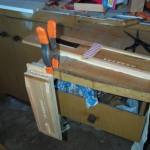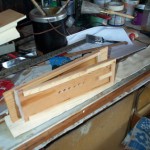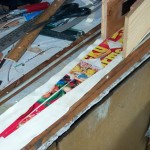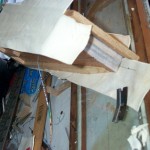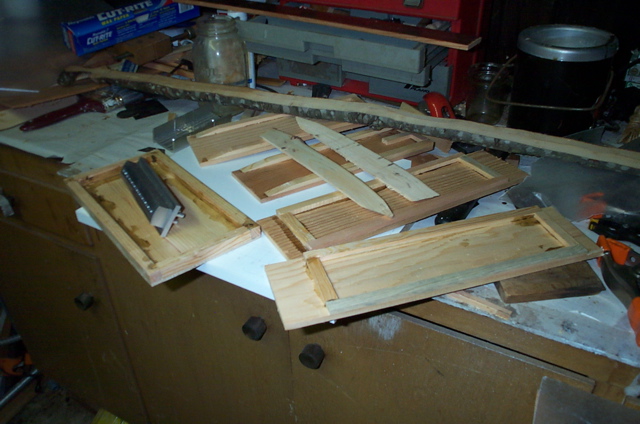At the end of a long day. Progress is not quite where I would have liked it to have been. This may still happen. I have 24 hours left, which accounting for a few hours of sleep probably gives 17 or 18 hours in which to get something playing.
ideally I would have the bellows pumping wind so the pipes can be made and voiced quickly. Instead, I was able to get the roll player section completed first. Mostly due to help from my friend Harold.
I decided before it got too dark, to saw up some more of the local wood. The band saw blade was dull, while cutting through a piece of the pear wood, the blade broke. I am pushing this saw to the limit. re-sawing the thick slabs of cherry is hard on this tool. Hopefully I can get a new blade in the morning.
Without a working band saw, I am unable to finish the pump sticks. Fortunately I had planned to do some of the gasketing after 9pm. Even though this is a semi-rural area, the sound does carry at night. Although as I was performing the leather work, I could hear a train which was a mile away quite clearly.
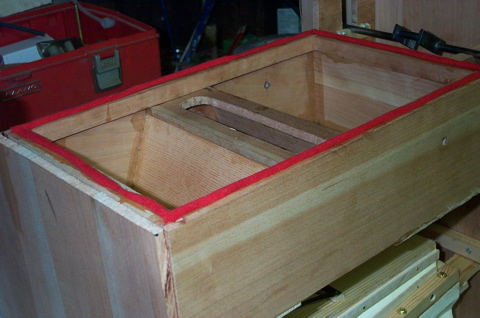 This is an interesting way of making a gasket. I am not sure if this is the best place for this method, but it seems worth a try. This is how Wurlitzer gaskets the regulators to the wind trunks.
This is an interesting way of making a gasket. I am not sure if this is the best place for this method, but it seems worth a try. This is how Wurlitzer gaskets the regulators to the wind trunks.
First a strip of felt is glued down the center of the frame. Then gasket leather is glued on ether side of the felt. It is important not to get glue on the top of the felt. The only packing leather I have is thick. I think what I used is some extra pouch leather I got for making Wurlitzer valves. Once we get pump sticks and the wind line drilled, then perhaps It will be seen if this works.
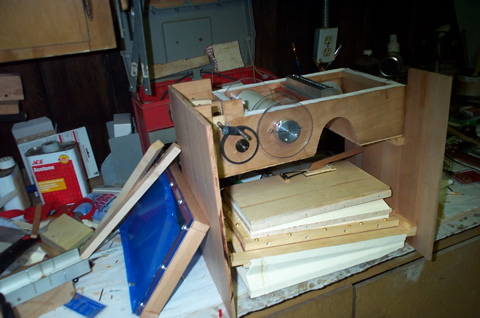 Finally we show the progress. All the main parts are in place and mounted to the sides. I did get a sheet of MDF for the pipe rack. Not sure when I will have time to cut it. I may just mount the pipes onto thin strips of board (I have a lot of that material.)
Finally we show the progress. All the main parts are in place and mounted to the sides. I did get a sheet of MDF for the pipe rack. Not sure when I will have time to cut it. I may just mount the pipes onto thin strips of board (I have a lot of that material.)
It will be interesting to see if this can be made playable in time for the event Saturday. Much of the detail, like the sanding and finishing of the cherry sides will not happen. The most critical part that needs to be fitted is the supply spool holder. This got delayed as a 10mm drill was needed. Not sure where the time to make this will happen.
Probably allowing for a week+ 2 days of preparation for this project was a bit optimistic. On the other hand, without the self imposed deadline, It is easy to defer many of the tasks. The important thing is the challenge of what can be done.
It should also be noted, that while the goal was to do the project in a week, the project has had the help of several people. Which is the focus on why this project has been selected, so it can be shared with whomever is interested.
Of course, the deadline of the 16th of May 2009 is artificial. Undoubtedly there will be improvements. Music will need to be acquired, spools made. Thee knob of the handle turned. The case varnished and decorated.
My late friend John Grass, used to say, the first part to make was the hardest one. So with this project I have at least started something.


